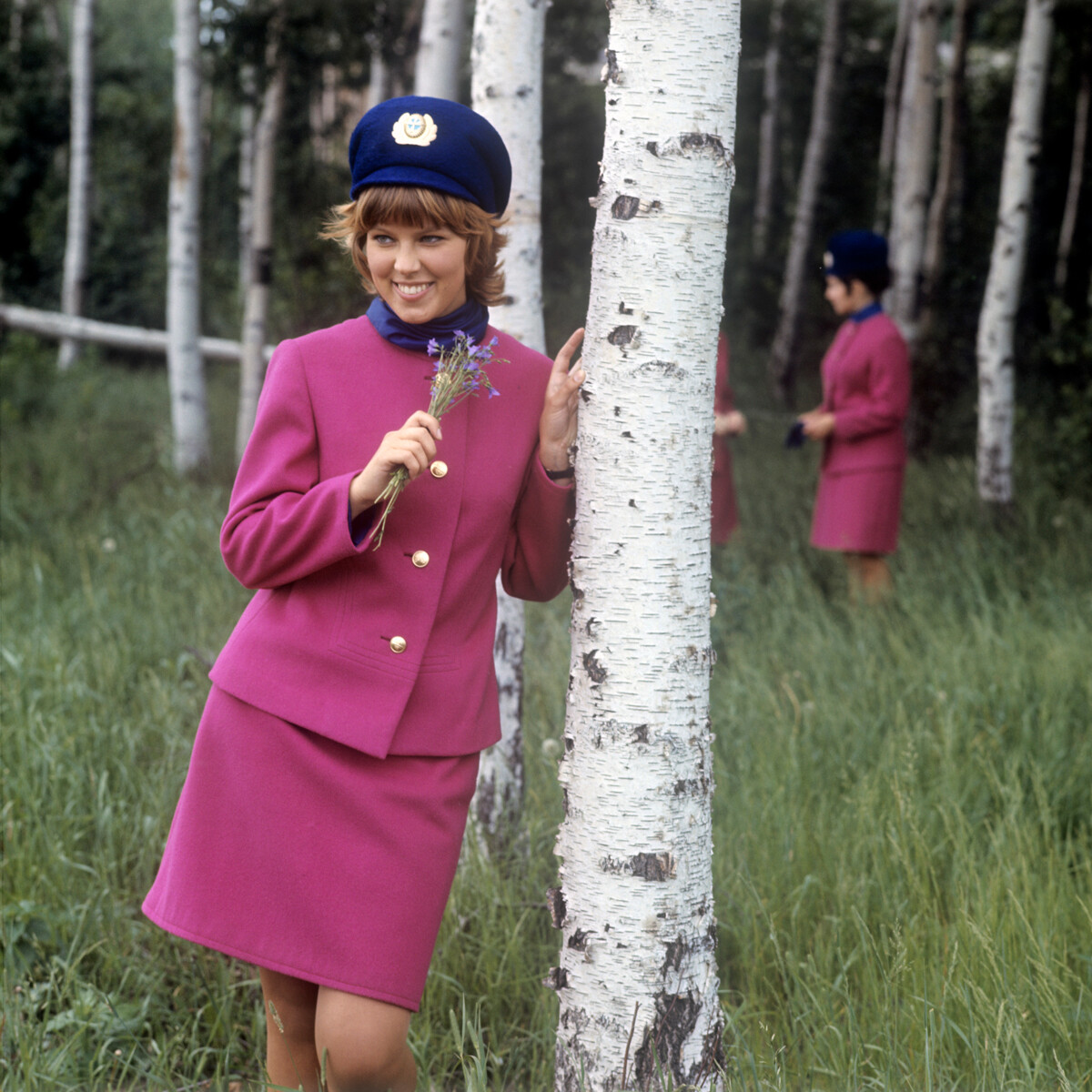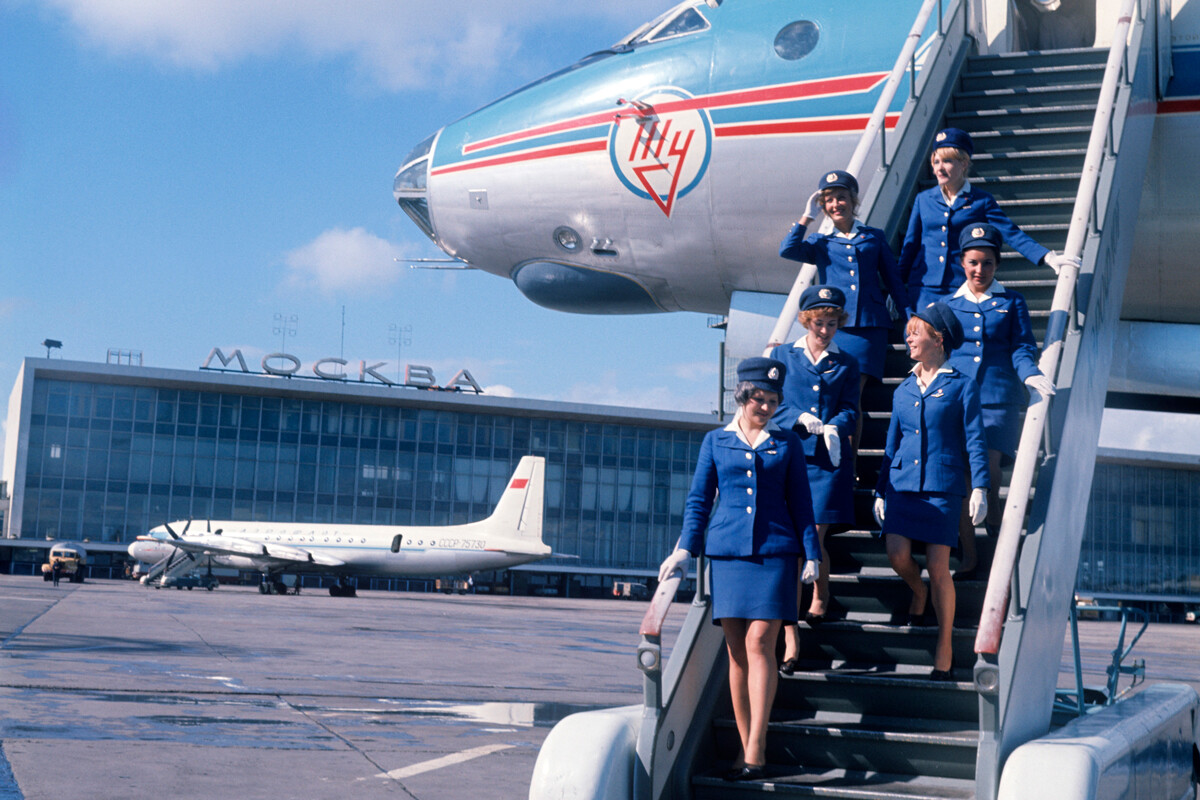How the Soviet flight attendant uniform changed over the years (PHOTOS)

In Soviet times, the profession of a flight attendant was considered very prestigious, especially for international flights. Not that many people used planes yet; when it came to flying abroad, only a select few could do so. Often, they were the elite from various fields. Aside from that, to travel overseas within one’s scope of work was a unique opportunity for Soviet citizens. Back then, there was only one airline, Aeroflot. Despite the monopoly, the uniform worn by flight attendants changed every several years; and its designers took into account all fashion trends!
How did flight attendants appear in the USSR?
 Moscow Vnukovo Airport. Aeroflot stewardess after a flight. 1961.
Moscow Vnukovo Airport. Aeroflot stewardess after a flight. 1961.
The first flight attendant of the Soviet Union was 20-year-old Elza Gorodetskaya. Back then, she worked on the Moscow-Ashgabat flight, on May 5, 1939. She had to purchase food from a refreshment room and bring it along with dishes onto the plane. Since her profession was not listed in the staffing table, she was initially registered as a pantry lady (according to different data, as a storekeeper).
 The first All-Union competition of flight attendants. The winner of the contest Ekaterina Kuznetsova performs. 1972.
The first All-Union competition of flight attendants. The winner of the contest Ekaterina Kuznetsova performs. 1972.
After the flight, Elza also had to clean the cabin by herself. She was the only worker of her kind for two months; after that, flight attendants began to appear on other flights, too. Only at the end of 1939 was the profession of a flight attendant formally approved. However, they didn’t have a particular uniform (unlike the pilots); they just had to look formal.
 Pilots and flight attendants on the Aeroflot aircraft ramp 1960s.
Pilots and flight attendants on the Aeroflot aircraft ramp 1960s.
After the war, flight attendants were issued a special clothing kit that included a wool suit, shoes, a beret, a fur jacket, an ushanka hat, valenki (felt boots), galoshes, gloves and other accessories. Usually, their suits were just dark and their blouses were sewn from silk. But, if there were not enough uniforms, they could simply wear a “white top and dark bottoms”.
The most fashionable suits
 Aeroflot stewardess V. Nazarova at Vnukovo Airport, 1966.
Aeroflot stewardess V. Nazarova at Vnukovo Airport, 1966.
The first mandatory uniform for Aeroflot appeared in 1954 for international flights. It was designed by the artists of the All-Union Model House in Moscow, based on the trends of the time. Women had dark-blue woolen suits with a fedora, a cape, shoes and gloves. For men, the uniform almost mirrored the pilots’ uniforms.
 Flight attendant Tamara Beisenova, 1961.
Flight attendant Tamara Beisenova, 1961.
In the 1960s, flight attendants in an established uniform began appearing on all types of flights. That was also linked to the rapid development of civil aviation: hundreds of cities of the Soviet Union had airports and airfields.
 Flight attendant, 1960s.
Flight attendant, 1960s.
In 1962, a summer light-gray suit complemented the blue suit. From 1968 on, it was already complemented by a pillbox hat – the latest fashion!
 Flight attendant Nadezhda Tkach. Sheremetyevo International Airport, 1971.
Flight attendant Nadezhda Tkach. Sheremetyevo International Airport, 1971.
 Flight attendant. Sheremetyevo International Airport. 1972.
Flight attendant. Sheremetyevo International Airport. 1972.
But, the 1970s were the most colorful years! A crimson uniform with golden buttons was designed for the flight attendants. When serving, they also put on blue aprons with Russian folk style patterns.
 Flight attendant. Sheremetyevo International Airport. 1972.
Flight attendant. Sheremetyevo International Airport. 1972.
Then, the Aeroflot parade uniform also appeared – blue with a broad white trim. When turtlenecks came into fashion, they replaced the flight attendants’ white buttoned shirts.
 Irina Naumova, flight attendant of the IL-62M, 1978.
Irina Naumova, flight attendant of the IL-62M, 1978.
 At Moscow Domodedovo Airport, 1974.
At Moscow Domodedovo Airport, 1974.
At the same time, Aeroflot began flying to hot countries more often, and specifically for such flights the designers introduced a separate uniform line: dresses and suits with short sleeves. In the 1970s, they were blue and red, in the 1980s – brown.
 Aeroflot's flight attendants pose near the Tupolev Tu-154B of Aeroflot Soviet Airlines at Tbilisi airport, Georgian Republic, USSR.
Aeroflot's flight attendants pose near the Tupolev Tu-154B of Aeroflot Soviet Airlines at Tbilisi airport, Georgian Republic, USSR.
Brand colors – red and blue
And yet, red and blue remained (and still remain) the main colors for the Aeroflot uniform, although the styles change.
 Kazakh SSR. Alma-Ata. Gulnara Kurbankhodzhaeva, a flight attendant, in front of a Tu-154 airliner in 1983.
Kazakh SSR. Alma-Ata. Gulnara Kurbankhodzhaeva, a flight attendant, in front of a Tu-154 airliner in 1983.
For example, for the female flight attendants who served the guests of the Moscow Olympics, a blue uniform with flared skirts was sewn.
 The crew of the IL-62M airliner at Sheremetyevo-2 international airport after the Moscow-Washington flight. 1986.
The crew of the IL-62M airliner at Sheremetyevo-2 international airport after the Moscow-Washington flight. 1986.
The last Soviet uniform was introduced in 1986. Its winter variant included a red hat and a red headscarf, while its summer variant – a sky-blue dress.
 Flight attendant Svetlana Zenkina is the winner of the international contest of professional skills of flight attendants of socialist airlines in Budapest. 1988.
Flight attendant Svetlana Zenkina is the winner of the international contest of professional skills of flight attendants of socialist airlines in Budapest. 1988.
By the moment of the Soviet Union’s dissolution, Aeroflot carried more than 140 million passengers per year (including both domestic and international flights). To this day, the company keeps its brand colors in their flight attendants’ uniform.
 Altai Krai. Barnaul. Flight attendant Elena Ivantsova loading sea buckthorn seedlings into the cargo compartment of a passenger airliner on June 1, 1991.
Altai Krai. Barnaul. Flight attendant Elena Ivantsova loading sea buckthorn seedlings into the cargo compartment of a passenger airliner on June 1, 1991.
And this is what the workers of other modern airlines of Russia look like.


